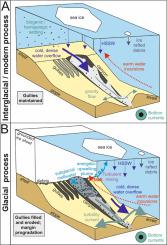当前位置:
X-MOL 学术
›
Geomorphology
›
论文详情
Our official English website, www.x-mol.net, welcomes your
feedback! (Note: you will need to create a separate account there.)
Role of dense shelf water in the development of Antarctic submarine canyon morphology
Geomorphology ( IF 3.1 ) Pub Date : 2021-01-01 , DOI: 10.1016/j.geomorph.2020.107453 J. Gales , M. Rebesco , L. De Santis , A. Bergamasco , F. Colleoni , S. Kim , D. Accettella , V. Kovacevic , Y. Liu , E. Olivo , E. Colizza , C. Florindo-Lopez , F. Zgur , R. McKay
Geomorphology ( IF 3.1 ) Pub Date : 2021-01-01 , DOI: 10.1016/j.geomorph.2020.107453 J. Gales , M. Rebesco , L. De Santis , A. Bergamasco , F. Colleoni , S. Kim , D. Accettella , V. Kovacevic , Y. Liu , E. Olivo , E. Colizza , C. Florindo-Lopez , F. Zgur , R. McKay

|
Abstract Increased ocean heat supply to the Antarctic continental shelves is projected to cause accelerated ice sheet loss and contribute significantly to global sea-level rise over coming decades. Changes in temperature or salinity of dense shelf waters around Antarctica, resulting from increased glacial meltwater input, have the potential to significantly impact the location and structure of the global Meridional Overturning Circulation, with seabed irregularities such as submarine canyons, driving these flows toward the abyss. Submarine canyons also influence the location of intruding warm water currents by acting as preferential routes for rising Circumpolar Deep Water. These global changes have implications for large-scale effects to atmospheric and oceanic circulation. The ability for numerical modellers to predict these future behaviours is dependent upon our ability to understand both modern and past oceanic, sedimentological and glaciological processes. This knowledge allows ocean models to better predict the flux and pathways of Circumpolar Deep Water delivery to the shelf, and consequently to ice shelf cavities where melt is concentrated. Here we seek to understand how dense shelf water and other continental slope processes influence submarine canyon morphology by analysing newly collected geophysical and oceanographic data from a region of significant and prolonged dense shelf water export, the Hillary Canyon in the Ross Sea. We find that cascading flows of dense shelf water do not contribute to significant gully incision at the shelf edge during interglacial periods, however, are strong enough to prevent gully infilling and contribute to canyon-levee aggradation down-slope. We find buried paleo-gullies beneath gullies incising the modern seafloor. Paleo-gullies occur as single gullies and in complexes indicating that gully activity was continuous over multiple glacial cycles and formed an important role in the development of the shelf edge and upper slope. Glacial cycles likely drive large-scale shifts in canyon head processes with periods of intense seafloor erosion and significant gully incision likely occurring when ice grounded near to the shelf edge, during glacial and deglacial periods, when sediment-laden subglacial meltwater was released at the shelf edge. We put slope morphology observed at the Hillary Canyon head into global perspective to show that cascading flows of dense shelf water do not exert consistent patterns of erosion on high-latitude continental margins.
中文翻译:

致密陆架水在南极海底峡谷形态发展中的作用
摘要 南极大陆架的海洋热量供应增加,预计将导致冰盖加速流失,并在未来几十年对全球海平面上升做出重大贡献。由于冰川融水输入增加,南极洲周围密集陆架水域的温度或盐度发生变化,有可能显着影响全球经向翻转环流的位置和结构,海底峡谷等海底不规则性将这些流动推向深渊. 海底峡谷还通过充当环绕极地深水上升的优先路线来影响侵入温水流的位置。这些全球变化会对大气和海洋环流产生大规模影响。数值建模者预测这些未来行为的能力取决于我们了解现代和过去海洋、沉积学和冰川学过程的能力。这些知识使海洋模型能够更好地预测环极深水输送到冰架的通量和路径,从而输送到融化集中的冰架空腔。在这里,我们试图通过分析新收集的地球物理和海洋学数据来了解密集的陆架水和其他大陆坡过程如何影响海底峡谷的形态,这些数据来自一个重要且长期的密集陆架水出口区域,即罗斯海的希拉里峡谷。我们发现,在间冰期,密集的陆架水的级联流不会导致陆架边缘出现明显的沟壑,但是,足够坚固以防止沟壑充填,并有助于峡谷-堤坝下坡。我们在切开现代海底的沟壑下方发现了埋藏的古沟壑。古沟壑以单一沟壑和复合沟壑的形式出现,表明沟壑活动在多个冰期循环中是连续的,并在陆架边缘和上坡的发育中形成了重要作用。冰川循环可能会推动峡谷头部过程的大规模变化,当冰在陆架边缘附近接地时,在冰川和冰消期期间,当富含沉积物的冰下融水在陆架上释放时,可能会发生剧烈的海底侵蚀和显着的沟壑切口。边缘。
更新日期:2021-01-01
中文翻译:

致密陆架水在南极海底峡谷形态发展中的作用
摘要 南极大陆架的海洋热量供应增加,预计将导致冰盖加速流失,并在未来几十年对全球海平面上升做出重大贡献。由于冰川融水输入增加,南极洲周围密集陆架水域的温度或盐度发生变化,有可能显着影响全球经向翻转环流的位置和结构,海底峡谷等海底不规则性将这些流动推向深渊. 海底峡谷还通过充当环绕极地深水上升的优先路线来影响侵入温水流的位置。这些全球变化会对大气和海洋环流产生大规模影响。数值建模者预测这些未来行为的能力取决于我们了解现代和过去海洋、沉积学和冰川学过程的能力。这些知识使海洋模型能够更好地预测环极深水输送到冰架的通量和路径,从而输送到融化集中的冰架空腔。在这里,我们试图通过分析新收集的地球物理和海洋学数据来了解密集的陆架水和其他大陆坡过程如何影响海底峡谷的形态,这些数据来自一个重要且长期的密集陆架水出口区域,即罗斯海的希拉里峡谷。我们发现,在间冰期,密集的陆架水的级联流不会导致陆架边缘出现明显的沟壑,但是,足够坚固以防止沟壑充填,并有助于峡谷-堤坝下坡。我们在切开现代海底的沟壑下方发现了埋藏的古沟壑。古沟壑以单一沟壑和复合沟壑的形式出现,表明沟壑活动在多个冰期循环中是连续的,并在陆架边缘和上坡的发育中形成了重要作用。冰川循环可能会推动峡谷头部过程的大规模变化,当冰在陆架边缘附近接地时,在冰川和冰消期期间,当富含沉积物的冰下融水在陆架上释放时,可能会发生剧烈的海底侵蚀和显着的沟壑切口。边缘。











































 京公网安备 11010802027423号
京公网安备 11010802027423号